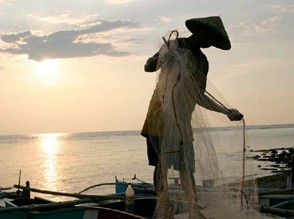
Ancient Chinese philosopher Lao Tzu once said that if you teach a person to fish you have fed him for a lifetime. However, if that person teaches others unsustainable fishing practices that produce long-term harm to the environment, such as overfishing, illegal fishing, and habitat degradation, will there be any resources left to feed anyone? In short, no. Not only would you find a hungry person, but you'd find over-populated communities of men, women, and children who would be negatively impacted by the increased demand for fish, leading to poverty and over-stressed coastal resources.
The Philippines is one of 16 countries where more than two-thirds of the world's biological diversity is concentrated. Biodiversity in the region is being threatened, with 70% of coral reefs destroyed, and the use of unsustainable fishing practices compromising food security. Fishing communities rely heavily on the fish caught as their main source of income and food. Productive fisheries that encourage, rather than threaten, biodiversity conservation efforts are of critical importance, particularly to the coastal fishers battling poverty in Bongao, Tawi-Tawi in the Philippines.
USAID has provided critical assistance to several fishing communities in the Philippines through its Fisheries Improved for Sustainable Harvest (FISH) project. The initiative's goal is to conserve biological diversity in ecologically and economically important marine ecosystems in the Philippines. The project is expected to increase marine fish stocks by at least 10% from the 2004 baselines in four areas over seven years. These project sites have been identified by USAID as being important biodiversity conservation areas: the Calamianes Islands in the province of Palawan, the Danajon Reef in the province of Bohol, the province of Tawi-Tawi, and the province of Surigao del Sur.
For many years, local fishers from the Philippine province of Tawi-Tawi, an area regarded by locals as an ideal fishing location, would collect fish using "fish pens" or "corrals." Unfortunately, those who lived elsewhere in town were suffering from a fish catch decline that was starting to alarm local officials and surrounding fishing communities.
In order to halt the decline, USAID provided technical assistance to the local government to set up a marine sanctuary, which would ensure more productive fisheries by protecting critical fish habitat. Real and lasting impact was felt after just one year of implementation. "Our [fish] corrals are yielding more because there are now so many fish inside and outside the sanctuary. Now all my relatives support the sanctuary," said Nasirin "Kah Nas", a guard for a USAID-supported marine sanctuary in the Philippines.
By supporting the efforts of local government, USAID, the Department of Agriculture's Bureau of Fisheries and Aquatic Resources (DA-BFAR) were able to elicit community cooperation utilizing a multi-level, integrated law enforcement approach that encourages compliance with the new sanctuary regulations. Because of USAID's continued support, the FISH Project has led to the establishment and/or strengthening of 32 Marine Protected Areas (MPAs), spanning 1,913 hectares (4,727 acres). The MPAs are now a centerpiece of fisheries management systems in 29 municipalities.
After identifying program barriers to growth, control, and maintenance, fisheries management mechanisms were demonstrated to have directly contributed to increases in fish stocks, allowing USAID to meet its objectives for the FISH Project. Project results showed that fish biomass across all sites increased 19 percent from a 2004 baseline, much higher than its original target of 10 percent.
If our person who was taught how to fish follows USAID and its implementing partners' integrated approach to creating productive fisheries, there will be plenty of resources to feed everyone. Not only will there be plenty of fish in the sea, but the fish will be varied in species and their habitats will be well preserved in a vibrant ecosystem—an ecosystem that will be able to accommodate and rise to future demands for at least the foreseeable future.







Comment
Make a general inquiry or suggest an improvement.